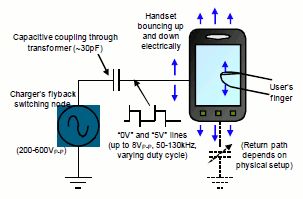Why does not my tablet touch screen work when powered with third party mains power supply, but works with the original power supply? This happened to me. The power supplied I had were both for tablets (different tablets) and had similar basic characteristics (same current and voltage ratings).
The reason why the other power supply caused the touch screen to fail was related to the noise given out by the power supplies and the touch screen electronics sensitivity to this noise. One power supply outputs more noise than the other. How this noise affect the touch screen electronics is shown in this picture MoU regarding Harmonisation of a Charging Capability for Mobile Phones, June 5th, 2009.
This is nothing new, just now well documented what happens. This same happens with practically any today’s mobile phone charged based on switch mode power supply technology. Smart-phones and tablets need to be designed so that they can live with it. And power supplies needs to be designed to that they do not put out too much noise. Some details on this can be found at my EU standards for common mobile phone charger article.
Dealing with noise is an important aspect of any real-world electronic system, especially in a capacitive touchscreen in a cell phone or tablet. Noise Immunity of Touchscreen Devices web page tells that while there are many sources of noise that can interfere with capacitive touch sensing, the most prominent ones originate in displays and battery chargers. Cypress Offers Battery Charger Noise Immunity web page tells that low-cost chargers lack critical noise suppression components and can generate tens of volts (peak to peak) across the frequency spectrum of 1 Hz to 1 MHz. These voltage spikes can go directly into the touch panel during the presence of touch, severely impacting touch performance. Mobile phone vendors have worked together to create EN 62684 and EN301489, standards that regulate the noise spectrum for battery chargers.
Cypress Offers Battery Charger Noise Immunity web page tells touch screen controllers are developing all the time. It tells that a new TrueTouch feature Charger Armor enables touchscreens in mobile devices to function seamlessly by preventing inaccurate touch readings, which are often caused by common-mode noise from inexpensive chargers.
It is a good thing that those touch controllers are improving, because many people (electronics designers and users) struggle to overcome charger noise.

5 Comments
Lilly Luni says:
Hi! I in the morning an university pupil conducting analysis about green energy concerning house-hold a source of electricity utilize. Kindly help to by taking a 5 minute survey: http://bit.ly/10xvSJw This could be helpful to bring attention to the importance of green energy in American households. Say thanks a ton!
Tomi Engdahl says:
Aggressively combat noise in capacitive touch applications
http://www.edn.com/design/sensors/4411529/Aggressively-combat-noise-in-capacitive-touch-applications
A touchscreen device can be subject to many different noise sources, both internal and external, in a given day. Charger and display noise are two of the most common and problematic noise sources today. As devices get thinner and noisier chargers enter the market, these challenges will only become tougher to manage. Additionally, many other everyday items can generate noise that causes interference, including radio signals, AC mains, and even fluorescent light ballasts. In the presence of noise, the positions reported by low-performance capacitive touch systems will be distorted impacting accuracy and reliability.
Today’s touchscreen controllers employ a wide variety of techniques both to increase SNR and to filter out bad data from noise: high-voltage Tx generated on-chip, specialized hardware acceleration, high-frequency Tx, adaptive frequency hopping, and saturation prevention techniques. However, touch technology continues to advance in how the touch controller utilizes these features, dynamically adapts to the noise present in the system, and accurately track touches despite changing environmental conditions.
Tomi Engdahl says:
EN62684, regulating the maximum allowable peak-to-peak voltages emitted by a charger across the frequency spectrum. This specification establishes that a charger should emit noise no more than 1 Vpp (from 1 kHz to 100 kHz), and even lower amplitude voltages at frequencies above 100 kHz. The typical aftermarket charger does not follow this guideline.
While quieter chargers produce noise on the order of 1 – 5 Vpp, noisy chargers can fluctuate in the 20 – 40 Vpp range, causing huge amounts of charge transfer. The amount of charge injected depends on the voltage amplitude of the noise (Q = C*V). Despite this massive amount of noise, the touchscreen controller must still be able to detect a finger which causes a change in charge that is several orders of magnitude smaller.
Fundamental frequencies of charger noise largely exist from 1 kHz to 300 kHz with lower amplitude harmonics at higher frequencies. This can be combated with high frequency scanning in the 300 kHz to 500 kHz range, completely avoiding the highest amplitude noise bands and the first few harmonics. This technique also improves display noise immunity as it moves away from LCD noise frequency ranges.
Source: http://www.edn.com/design/sensors/4411529/2/Aggressively-combat-noise-in-capacitive-touch-applications
Check my Website says:
You realize so considerably with reference to this condition, forced me to be separately ponder over it at a lot of different facets. It has the like people may not be involved except if it is something about Kesha! Your individual stuffs great. Always cope with it down!
led screens says:
Just want to say your article is as astounding.
The clarity for your put up is just spectacular and that i could suppose
you are an expert on this subject. Fine along with your permission allow
me to take hold of your feed to stay updated with drawing close post.
Thanks a million and please carry on the gratifying work.